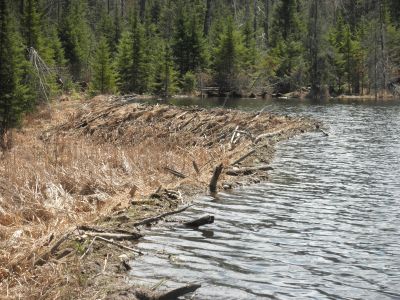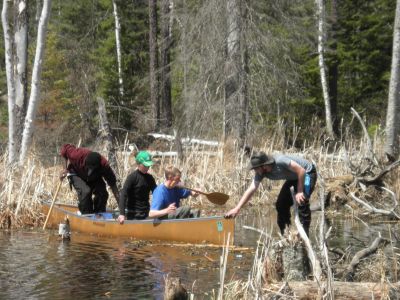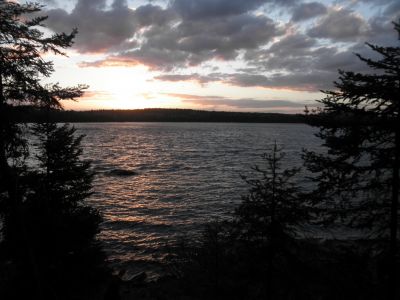The teeming wildlife within the Boundary Waters is truly extraordinary, however a large portion of the ecosystem of the lakes can be attributed to one creature in particular: the beaver.

The source of our swamped portage trail came from this spectacle of beaver engineering, only a few feet from the trail.
According to my brother, Clinton, a guide from Wilderness Wind Outfitters, it is not illegal to hunt and trap beavers–however dismantling a beaver lodge or dam carries serious legal consequences.
On our third day in the waters, with the realization that we needed to backtrack, beaver dams became somewhat of a nuisance. A beaver dam turns a forest into a swamp very quickly, and in turn submerged some of our portage trails.
As we began the 216 rod portage between Upper Pawness Lake and Shell Lake, a few fisherman were coming the opposite direction, and informed us about a swamped section of the portage trail.
They mentioned that in that section, we would need to put our canoes in the water and paddle across the swamped area; the water was waist deep. We made it through the trail unharmed albeit a little bit wet, though it slowed our progress significantly.

When a beaver blocks up a river with a dam, it does much more than create an obstacle for paddlers. A beaver dam provides a home for the beaver, but also a haven for many creatures of land and sea, as well as a hunting ground for their predators.
One could even think of the beaver as one of the foundations for early American commerce. The French voyageurs and early pioneers came through to trade guns and supplies to Native Americans in exchange for beaver furs.
The fishermen that crossed our paths also brought information about our course ahead, indicating an ideal fishing spot on Little Shell Lake. Even though Shell Lake at the end of that portage was clear, they said, another lake on our route, Lynx Lake, was covered with ice when they had last checked.

Starting from our first campsite, we retraced our path South into Upper Pawness, before heading through a partly swamped portage trail into Shell Lake, where we made camp.
When we reached the end of the portage, we crossed a large portion of the lake and stopped at an island campsite for lunch. The prospect was presented to make camp and settle in for the evening due to the information presented by the fishermen.
Instead, our group decided to head South to the next site in hopes for a more ideal spot. By this point in the day, the sun lent a great deal of heat. In spite of the ice a few lakes East, our group was putting on our shorts and enjoying the weather.
Shell Lake proved to be very windy, which made drying the clothes we soaked at the last swamp very easy. As the wind calmed to a gentle breeze, we returned to our tents and prepared for the next day’s adventure.








